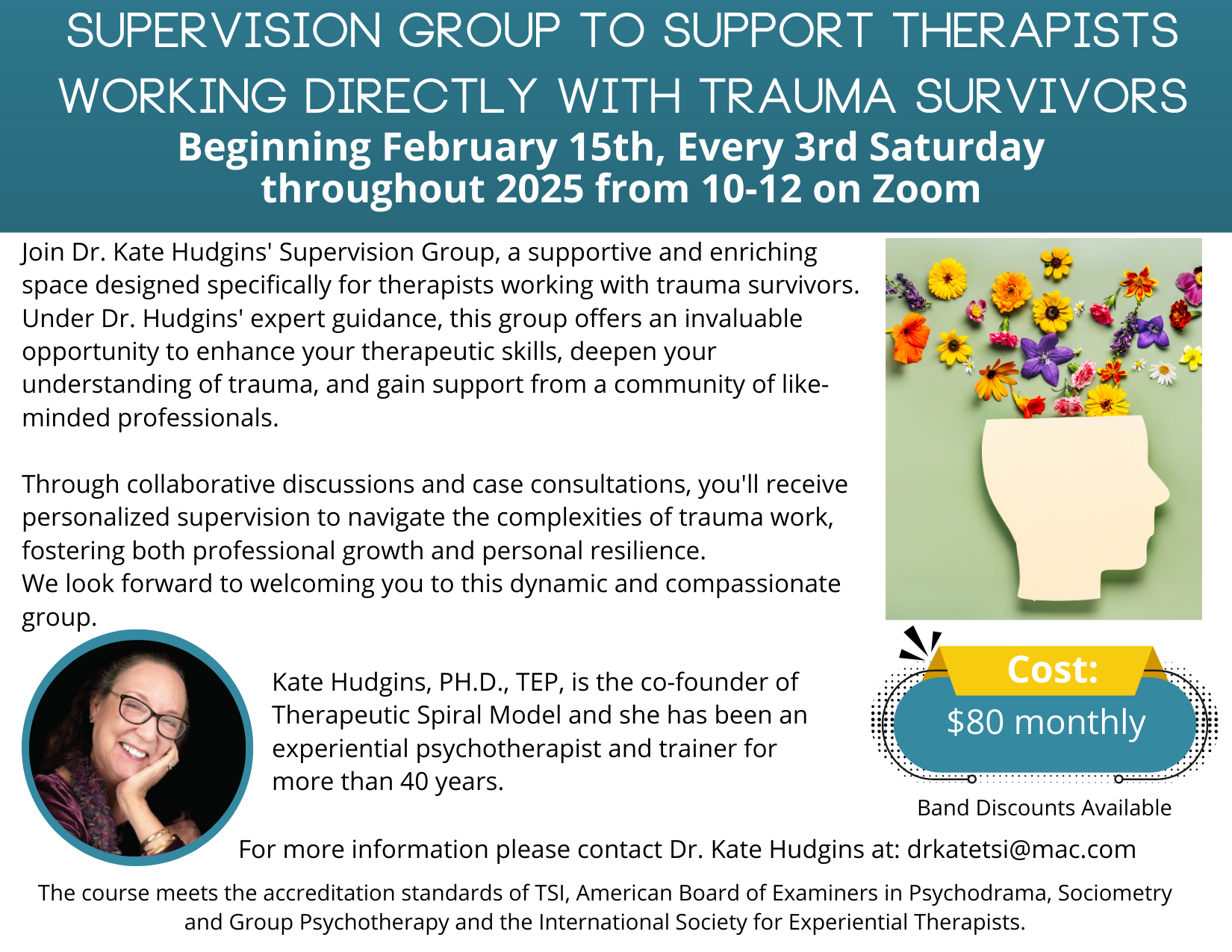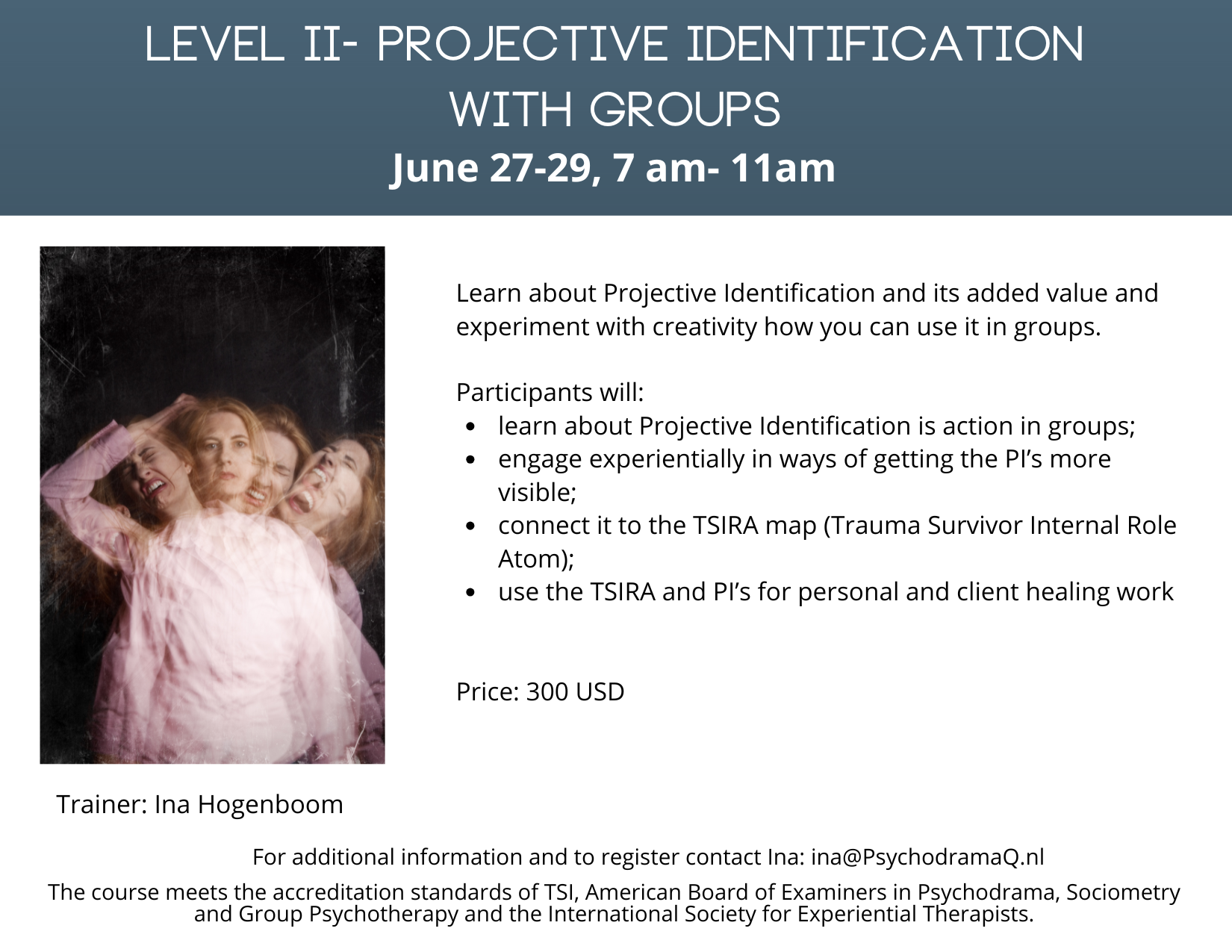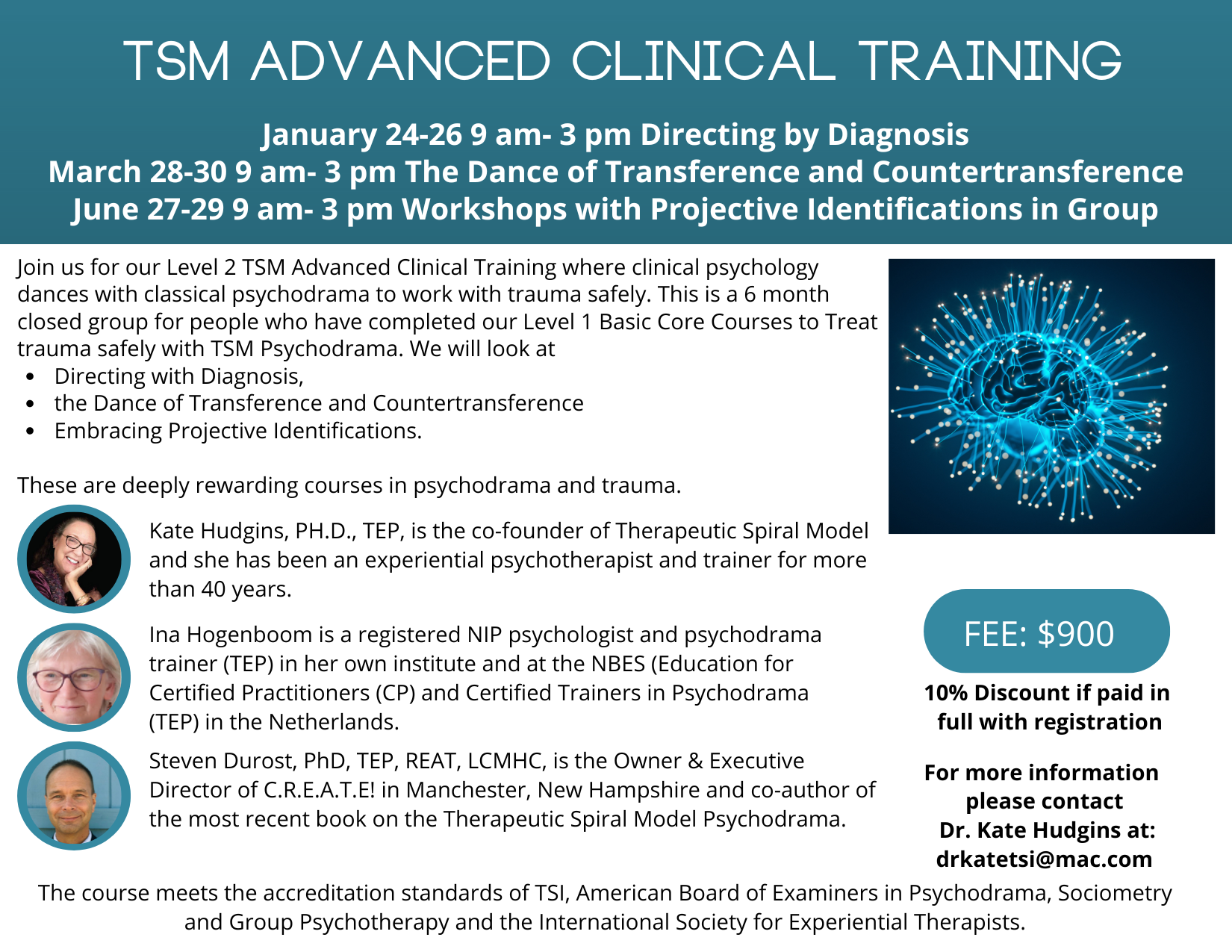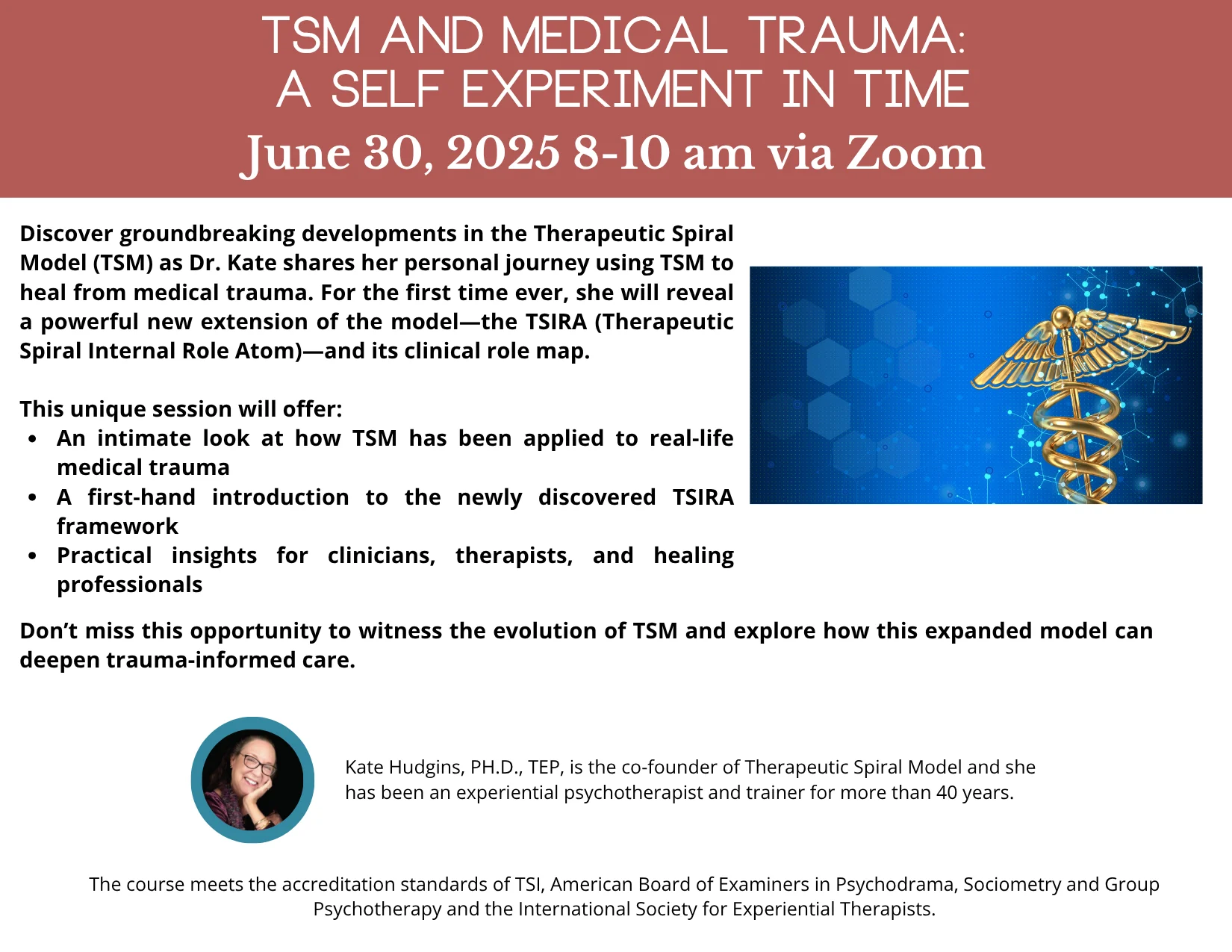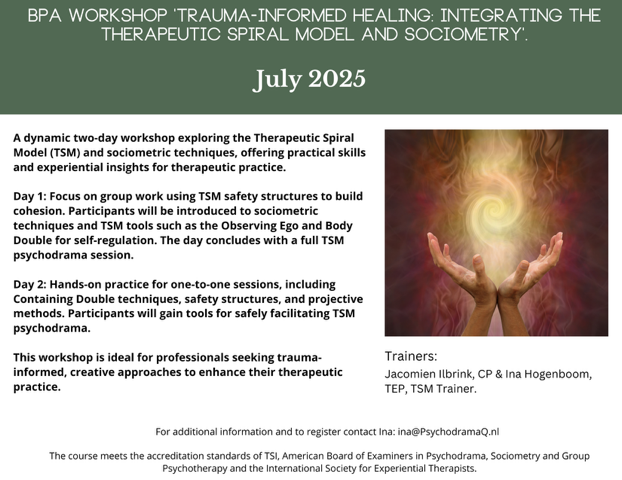TSI Certification Process
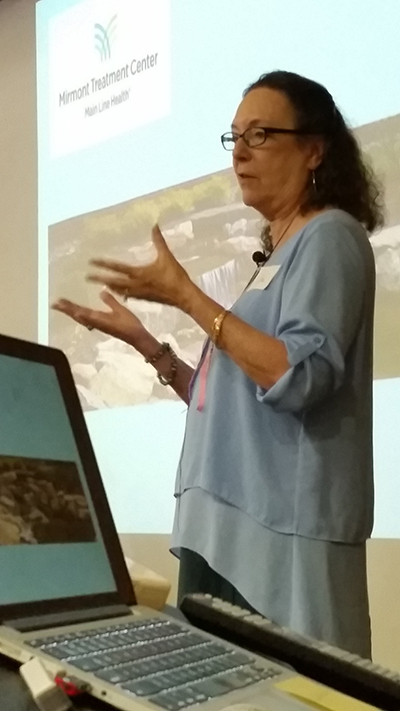
Dr Kate teaching at Mirmont Treatment Center, Lima, PA
What is TSM?
The Therapeutic Spiral Model (TSM) is a form of clinically-modified psychodrama used for the safe and effective treatment of trauma. Since the inception of TSM in 1992, thousands of people around the world have benefited from its application. TSM addresses trauma resulting from physical/emotional abuse, childhood sexual abuse, rape and sexual assault, ethnic conflict, torture and other forms of political violence. TSM is based on the premise that survivors of trauma need to be adequately resourced with a set of roles that can be internalized for greater awareness, resilience, and post-traumatic growth. Only when this is accomplished can survivors fully explore, understand, and release themselves from the debilitating impact of traumatic events.
Certification as a TSM Psychodramatist
Therapeutic Spiral International (TSI) presents an International Certification in Experiential Trauma Therapy, at four levels, using the Therapeutic Spiral Model (TSM): Trained Auxiliary Ego (TAE), Assistant Leader (AL), Team Leader (TL), and TSI Trainer. This is an acknowledged and research-supported method of using clinically modified psychodrama and experiential psychotherapy to treat trauma with individuals, groups, and communities who present with symptoms of PTSD, anxiety, or depression. It has also been applied to addictions and eating disorders, as well as to uses in education, theatre, community building, business, and law.
TSI offers a comprehensive training program in TSM psychodrama to treat Post-Traumatic Stress Disorder and its aftermath that when completed fulfill the TSI requirements for International Certification in Trauma Therapy. This training is for mental health care professionals, educators, community organizers, business persons, lawyers, or volunteers who wish to learn or improve their skills in working with people who are highly stressed or suffer from PTSD.
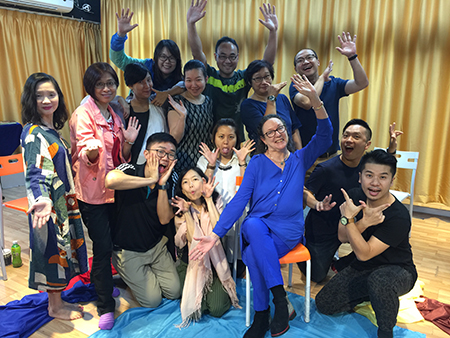 Training workshops for 2017-2018 are currently scheduled in the United States, Canada, China, Egypt, Korea, Norway, Spain, Sweden, and Taiwan with more to be added. Teams are also available for training in Australia, England, New Zealand and South Africa. Students who complete this two-year program will receive an International Certification in Trauma Therapy using the Therapeutic Spiral Model.
Training workshops for 2017-2018 are currently scheduled in the United States, Canada, China, Egypt, Korea, Norway, Spain, Sweden, and Taiwan with more to be added. Teams are also available for training in Australia, England, New Zealand and South Africa. Students who complete this two-year program will receive an International Certification in Trauma Therapy using the Therapeutic Spiral Model.
Kate Hudgins, Ph.D., TEP, is the current director of training, lead trainer, and supervisor and may be assisted by one or more faculty members or senior clinicians in training. Excellent supervision-in-person, Skype, video, and written is provided to maintain the highest levels of safety and learning for students in the certification program.
Continuing Education Credits
Credit hours for trainings with Kate Hudgins, Ph.D., TEP, and other certified TSI Trainers who are also TEPs, are provided for psychodrama certification with the American Board of Examiners in Psychodrama, Sociometry and Group Psychotherapy and the American Society for Experiential Therapists. Credits count toward the International Certification in Trauma Therapy using the Therapeutic Spiral Model. In addition, continuing education hours are available for psychologists, social workers, family and marriage therapists, addictions counselors, licensed professional counselors, and certified group psychotherapists, depending upon the site.
Structure of the TSI Certification Program
TSI International Certification in Trauma Therapy includes theory, practice, and supervision. There are 7 required courses that can also be used as stand-alone workshops that produce immediately useful TSM clinical action interventions. This comprehensive training program with it’s highly experiential format is presented in weekends and week-long intensives and teaches participants how to address trauma safely with action methods.
Each course is a minimum of 3 days and earns hours of training with TSI and with the American Board of Examiners in Psychodrama, Sociometry and Group Psychotherapy. Hours can also be counted for the psychodrama requirements in Drama Therapy and toward certification with the Society of Experiential Therapists. At most sites in the USA, CE credits for psychologists, social workers, addictions counselors, and marriage and family therapists are also available.

Spontaneity and creativity are the curative agents of change when using psychodramatic methods and TSM to treat trauma (Hudgins & Toscani, 2013). Spontaneity, from a psychodrama view, is the ability to change a repetitive behavioral reaction to an old situation or adapt an appropriate behavior to a new situation. Using this definition of spontaneity, then, means that different interventions are therapeutically indicated with different clients and symptoms. This emphasis on spontaneity and creativity as the change agent is an ideal antidote for trauma survivors who are often depleted physically and emotionally and constricted in their behavioral repertoire. Thus, TSM guarantees resilience and prevents retraumatization with experiential methods.
Because of the use of demonstrations, supervised technique practice, and full TSM Psychodramas, skills are developed quickly and effectively. In addition, all participants have the opportunity to focus on their personal issues and to assist with others’ healing. Often people start with attendance at a personal growth workshop for professionals to experience TSM for themselves and to meet the requirement for a personal experience in addition to the training requirements.
Courses and Workshops for TSI Certification
Level 1: Core Trauma Courses
- The Brain in Action: The Neurobiology of Trauma
- Containment: The Key to Safety with Actions Methods
- Working with Defenses in Action
- Transforming the TSM Trauma Triangle
Level 2: Advanced Clinical Courses
- Differential Directing and Team Practice with Action Methods
- The Dance of Transference and Countertransference with Trauma Survivors
- Using Projective Identification in Groups
Required reading includes Experiential Therapy to Treat PTSD: The Therapeutic Spiral Model (Hudgins, 2001) Healing Word Trauma with the Therapeutic Spiral Model: Stories from the Frontlines (Hudgins & Toscani, Eds., 2013). All courses will have handouts and supplemental readings. Since this is an experiential method, the majority of the learning is in action with demonstrations, live supervision, protagonist-centered psychodramas, sociodrama, and Playback Theatre.
Overall Participants Learn:
- Why experiential therapy is the best treatment for PTSD, according to the most recent neurobiological studies.
- Basic psychodrama skills of doubling, mirroring, soliloquy, role taking, role playing, and role reversal
- The clinical modification of these basic psychodrama skills to work with trauma in a contained action structure
- The structure of any psychodrama, including warm-up, action and sharing.
- The TSM Six Safety Action Structures.
- The Trauma Survivor’s Internal Role Atom (TSIRA) that provides a clinical guide for all experiential therapies for safety and direction.
- How to instill the TSM Prescriptive Roles to promote resilience through spontaneity and creativity.
- The Use of the TSM Trauma Triangle to show the internalization of trauma into victim, perpetrator, and the abandoning authority role and how to change that with the addition of the appropriate authority role.
- Promotion of post-traumatic growth through the TSM Transformative Roles.
- Immediately useful hands-on, experiential interventions for containment, exploration, and transformation of stress and trauma.
- The use of sociometry to create safety and authentic connection in groups.
- The integration of art and ritual to assist deep healing.
- How to develop applications specific to your needs in working with trauma.
Participants can earn a Completion of Theory Requirements for TSI Certification simply by attending all 7 courses. There is no specific time limit in which to complete these courses.
Practice
In the second part of the program, each student designs their own practica with Dr. Kate Hudgins or other TSI supervisor to meet the behavioral demonstration of specific skill sets to be certified as a Trained Auxiliary Ego, Assistant Leader, Team Leader, and TSI Trainer. Professional practica can be established in any setting the person works in, from individual therapy to social activism.
Action Healing Teams
Each TSI workshop has an Action Healing team, which is comprised of a certified trainer or team leader (TL), an assistant leader (AL), and at least two trained auxiliary egos (TAE). These teams are used in both training and personal growth workshops and provide an opportunity for people in training to receive live supervision and immediate feedback on their skills in the above roles. These teams are designed to provide the utmost in safety and containment even in the most intense emotional TSM psychodramas.
The TL provides the overall leadership and direction for each workshop. They are responsible for directing the majority of TSM dramas and supporting all team members in their learning and personal processes. In this way, containment and safety are guaranteed for all participants.
The AL focusses primarily on the connections between the group members and the team, most importantly the director of the drama. Essentially, the AL is the double of the director, meaning that they tune into the clinical intentions and action structures that the TL is implementing. To accomplish this, a primary duty is to communicate information from the TAEs to the TL so that every group member is included in the drama, regardless of the size of the group.
TAEs enact all roles from the TSIRA that are needed throughout the workshop. In enacting each role, they strive for a clinical intervention that fits into the overall needs of group members. For example, during the prescriptive role scene they may be asked to provide the unique TSM roles of self-regulation (Body Double) and containment (Containing Double), as noted below. During the trauma scene, they prevent retraumatization by taking the roles of victim or perpetrator.
Clinicians in training often use their team training to build their own local teams in inpatient settings, private practice, organizations, and community venues.
Supervision
The final part of TSI Certification is clinical supervision. After submitting an initial application and resume, each person is assigned a TSI supervisor that best suits their needs after a discussion with the Director of Training. Each student who is in the certification program must meet monthly via Skype, in person, or by phone. This can be individual or group supervision. Individual is an hour to an hour and a half. Group supervision is 2-3 hours. Live supervised practice is included when you participate on TSI Action Healing Teams.
Level 1 TSI Core Trauma Courses/Workshops:
The Basics of Psychodrama, Trauma, and The Therapeutic Spiral Model
Throughout the 4 Core trauma courses, we teach the basic psychodrama skills of doubling, role reversal, sociometry, sociodrama, Playback Theatre, and others from classical psychodrama. In addition, specific clinically modified TSM interventions for safety when working with trauma (difficult students, clients, managers, et al.) are taught through the clinical map of the Trauma Survivor’s Internal Role Atom (TSIRA)—essentially a map of a person’s psyche. This encourages practitioners to use the TSIRA map in a setting of choice, including clinical practice, education, community organizing, business, law, and volunteer work.
Workshop 1: Neurobiology of Trauma
We now know that people who have experienced traumatic events have significant changes in the neurobiology of their brain. The right brain, which holds emotions, relationship information, unprocessed trauma in the form of flashbacks, body memories, intrusive thoughts, and dissociated feelings, is always turned on by an overactive amygdala. Meanwhile, the left brain’s coherent function, which provides meaning and helps people stay in the here and now, is interrupted by stress hormones as the result of the danger signals from the hypothalamus. Most recently, research has shown that much more of the brain develops through interpersonal interaction showing changes in the brain in the poly-vagal nerve, and in other deeper brain structures than were previously thought to exist.
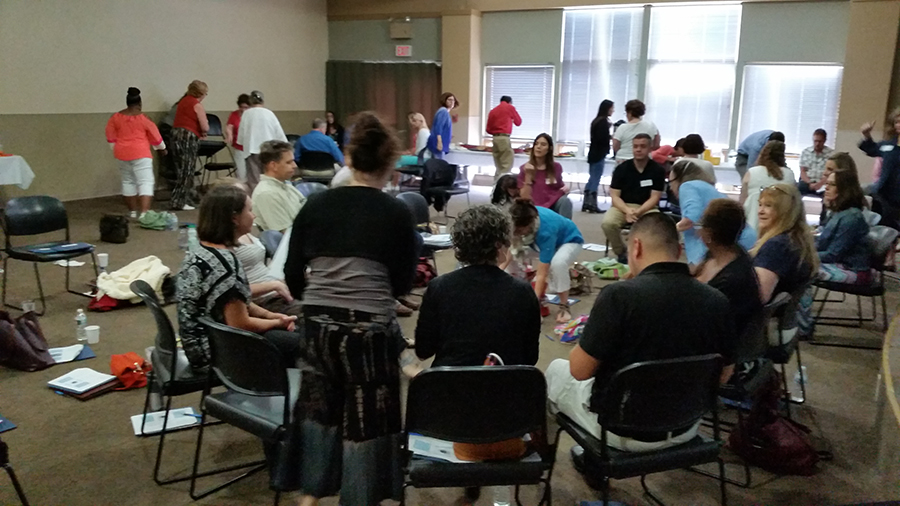
This course specifically teaches the Neurobiology of PTSD in Action. We examine many simulated as well as real situations, with participants bringing their own and clients’ stories to the group. Using the Brain in Action, a unique TSM way of demonstrating the neurobiological changes in the brain, allows people a visual learning tool that helps translate the often-difficult language of interpersonal neurobiology into a simple action structure.
This workshop also teaches specific TSM interventions to address the very primal defenses against trauma, including the Body Double (BD) created by TSI Trainer, Linda Ciotola, M.Ed, TEP (Burden & Ciotola, 2002). The BD is a role that attunes the client to their own bodily sensations, thoughts, and feelings in order to provide self-regulation, self-soothing, and narrative labeling. The BD was developed to decrease dissociation and help people experience their body in a healthy way, even during a flashback or body memory, and helps calm and soothe them.
Participants Learn:
- The most recent research on the brain and attachment as affected by trauma.
- Why experiential treatment is the treatment of choice for trauma and other stress related disorders, including addictions and eating disorders.
- The structures and processes of both the healthy and traumatized brain shown through the Brain in Action.
- The TSM Body Double clinical action intervention module.
- Applied applications in the setting of choice.
Workshop 2: Containment-The Key to Safety with Action Methods
During this Level 1 TSI course, we present the overall template or protocol for conducting TSM psychodrama and all experiential therapy methods safely, regardless of the problem a trauma survivor presents. The Trauma Survivor’s Internal Role Atom (TSIRA) in presented in its fullness. It teaches how TSM’s internal roles, especially the prescriptive roles of the TSIRA, can be adapted to help with residual trauma through containment and accurate labeling. Participants learn to balance thinking and feeling so that old, unprocessed memories can be held safely in the present, and reexamined from the here-and-now perspective to find new solutions for old repetitive trauma patterns.
This workshop also teaches a core TSM action intervention called the Containing Double (CD) (Toscani & Hudgins, 1993), which helps clients with trauma balance the thinking and feeling parts of their brain. This enables them to stay in the present and make new, spontaneous and creative actions. Demonstration and supervised practice of the CD shows how to make the container bigger, as well as smaller, for obsessive thoughts, defenses, and deep feelings. The CD becomes a bridge from defenses to being present in the here-and-now and is the most used TSM intervention worldwide (Hudgins & Toscani, 2013).
Participants learn:
- What containment is and why it is needed with experiential methods of change.
- The 3 stages of TSM protocol from the clinically-based TSIRA: Prescriptive, Trauma-based, and Transformative Roles.
- The specific TSM clinical action intervention of the Containing Double (CD) to provide balance of thinking and feeling at all times.
- Safe expression of deep feelings of grief, rage, despair, and terror for developmental repair.
- Accurate labeling of thoughts and feelings to guide integrated action that changes old trauma patterns.
Workshop 3: Working with Defenses in Action
In this workshop, we focus on the defenses people use at the time of trauma to protect themselves to ensure survival, which then become part of the trauma-survivor’s role repertoire into adulthood. Categories of defenses include: Survival, obsessions, compulsions, addictions and eating disorders, as well as those that are simply maladaptive, but deeply rooted. While they worked initially, we see how they can become pathological when they are no longer needed and do not support growth—i.e., true spontaneity and creativity.
The TSM clinical action intervention of the Manger of Defenses (MD) is taught as a two-part structure in which any defense can be concretized through enactment or with the use of objects to represent it. When the MD is established it determines when and if a defense is needed, thus ensuring that old defenses can evolve into healthy psychological protection in the here and now.
Participants learn:
- An overview of defense mechanisms that develop following trauma: Survival, obsessions, compulsions, addictions and eating disorders, as well as maladaptive coping skills.
- The TSM clinical action intervention of the MD and how to use it in clinical situations and adapt its use to other settings.
- To identify their personal defenses that are used most frequently and how to transform them into higher order coping skills.
Workshop 4: Transforming the Trauma Triangle
In this workshop, we begin to focus on the trauma-based roles of the TSIRA by learning TSM’s Trauma Triangle—a configuration that clarifies the destructive cycle of Victim, Perpetrator, and Abandoning Authority. In addictions treatment, Karpman’s Triangle is well-known with the interpersonal roles of Victim, Perpetrator and Rescuer. Through years of clinical experience, we’ve redefined this triangle to represent the internalized experience of the trauma survivor. Using role theory, TSM’s Trauma Triangle incorporates the trauma-based roles of Victim, Perpetrator and Abandoning Authority, this last which is internalized when there is no rescuer available in the interpersonal world. The unique TSM role of the Abandoning Authority helps describes how trauma survivors learn to abandon themselves to dissociation, self-harm, addictions, eating disorders, and lack of self-care.
The Trauma Triangle represents a closed circuit of energy embedded in the personality structure of those who have survived cruelty or trauma, repeating itself as life-long patterns of abuse and neglect. Through personal dramas, this training provides tools to transform the trauma-based roles, empowering transformation from self-neglect to self-care, and instilling healthy problem-solving into daily life. The transformative role of Appropriate Authority is taught as the antidote to the TSM Trauma Triangle using action demonstrations and full psychodramas.
Assessment and enactment of the TSM Trauma Triangle is taught as a pen and paper tool, in action by walking the triangle, using sociodrama, or individual psychodramas.
Participants learn:
- The TSM Trauma Triangle and its many uses in education, therapy, and organizations.
- Assessment methods of the TSM trauma-based roles of victim, perpetrator, and abandoning authority.
- To integrate TSM’s prescriptive roles to enact and transform the trauma-based roles safely without re-traumatization.
- To identify a personal pattern on the Trauma Triangle.
- To transform the identified pattern and build the role of appropriate authority that can stop the repetitious internalized pattern of trauma.
Level 2: TSI Advanced Clinical Courses
Level 2 courses teach participants more advanced observation and intervention skills in experiential action work for all settings. These clinical skills are not taught in any other psychodrama training program in the world. The courses provide deep, hands-on psychological learning about the psychodramatic process and nuances of personal and group psychology. Additionally, they afford exceptional personal growth opportunities.
As in Level 1, participants receive supervision while working in their own practice setting, during TSM dramas as team members, and in the processing of dramas. Protagonist opportunities and personal growth are included in all the workshops. By the end of Level 2 Advanced Clinical Workshops, participants will have identified their strengths and vulnerabilities of working in the roles of TAE, AL, and TL. They will have had the opportunities to work both with and without a team, while using the clinical skills in all settings, including education, therapy, and organizations.
Workshop 5: Differential Directing and Team Practice
The group will review and bring to life DSM-V diagnoses of mood, personality, dissociative, addictive and eating disorders. Additionally, we have added a workshop on attachment and trauma that also meets this requirement. The focal point of this workshop is on learning which of the TSM clinical action interventions are best suited to promote change with various diagnoses.
This Level 2 workshop also explores the Team Roles in depth and how to work both with and without a team using the clinical principles and structures of TSM. Participants take the roles of team leader, assistant, auxiliary, and protagonist experiencing their own healing, both personally and professionally, along the way. This workshop models and teaches how to work as an open, honest, and transparent team.
Participants learn:
- The DSM-V criteria for diagnoses of mood, personality, dissociative, addictive and eating disorders, and attachment and trauma.
- Specific use of TSM clinical action interventions from the TSIRA, tailored to each diagnosis.
- The TSM Action Healing Team roles, with an opportunity to practice one or more of the roles: TL, AL, TAE, or protagonist.
Workshop 6: The Dance of Transference and Countertransference
In the previous workshop we addressed working with different diagnoses; here we focus on the important issues of transference and countertransference when working with trauma survivors. The role of therapist, teacher, or leader of any sort sets the stage for a dance that has a few steps but can become quite intricate and inextricable, as the client transfers roles from the past onto them. Therefore, it is important that the practitioner become skilled in labeling the transference without getting caught in it.
On the flip side of the coin, many practitioners find it an intense and chaotic experience to work with trauma survivors due to countertransference that gets triggered by stories of horror, terror, rage, grief, and despair. Some defenses may be dissociation, denial, minimization, over-identification, and role reciprocity as they’re pulled into the dance of trauma.
This workshop gives participants a deep personal and professional understanding of the clinical depictions of transference and countertransference—and how they can help or hurt the therapeutic process. Participants will practice the ‘asocial response’ in action, which implements the TSM observing ego role by providing a neutral stance and accurate information to both client and therapist. In this way the dance of transference and countertransference is interrupted.
Participants learn:
- The signs of transference from clients or students, including positive, negative, and erotic transference.
- To regain the appropriate authority role to mirror for clients their transferences as good/bad mother or father, etc.
- The ‘asocial response’, interrupting the cycle of projecting the past into current relationships.
- To work with transference and countertransference in individual therapy and in small groups, as well as in full dramas.
Workshop 7: Using Projective Identification with Groups
This workshop teaches the difficult-to-understand clinical concept of projective identification (PI) through action exercises and during individual and group sessions. Projective identification is a normal psychological function for a baby, whereby the baby projects intense affect onto others in order to achieve accurate labeling and self-soothing. When these feelings are not accurately labeled due to trauma or attachment disruption, this becomes a lifelong pattern of behavior or defense mechanism.
When they present, PI’s are unsettling to group process as much as to personal relationships and they seem to appear at intense emotional moments. This is especially so with trauma survivors who often trigger off of each other’s affect. Participants learn to identify and use PI’s in service of the person or group instead of having them disrupt a potentially healthy situation. For example, the AL identifies PIs that are being triggered in group members and helps the TL integrate them into the drama.
Participants learn:
- The clinical concept of projective identification.
- To experience and label feelings that are projected from others.
- To set boundaries that protect from being triggered into personal issues.
- To use PIs in the service of others, helping them label unconscious feelings and observe their projection onto others.
- Processing of dramas from the viewpoint of the use of PIs.
This workshop completes the 2-year series of TSM theory courses that leads to International Certification in Trauma Therapy Using the Therapeutic Spiral Model. Participants may be certified as TAE, AL, and TL depending upon completion of supervision plans and requirements met by the end of the theory courses and completing check-lists of specific TSM practitioner competencies.
To become a full certified Trainer of TSM requires at least two additional years. However, at the end of this course, participants doing Trainer practica will be given the authority to supervise or train others and give them International Certification Credit in the TSI Program on Trauma Therapy using the Therapeutic Spiral Model.
Diploma Programs:
Additionally, TSI offers two international Diploma programs in Egypt and in South Korea. These programs are adapted from the full TSI certification in trauma therapy, reflecting the needs of different settings and cultures. The program in South Korea is modified to work with educators, while the program in Egypt is designed to work with structural violence.
South Korea
This Diploma in TSM Psychodrama will be awarded through the collective efforts of the Institute for Bibliodrama and Drama Therapy, Seoul; Motivational Arts Unlimited (MAU), Indonesia; and Therapeutic Spiral International (TSI), USA. It will require a total of 400 hours of training in TSM Psychodrama, provided by a TSI-Accredited Trainer. All hours obtained are also accepted for Psychodrama Certification by the American Board of Examiners and the Korean Psychodrama Association.
Egypt
The 3-year Diploma in TSM offers a comprehensive training path for psychiatrists, psychotherapists and social workers who wish to develop skills in the use of psychodrama for transforming individual and collective trauma. The program includes experiential immersion in TSM through intensive training blocks, student directing, readings and written assignments. Participants will also undertake supervised practice in community-based interventions using TSM to address various forms of violence and oppression. Graduates of the program will receive a Diploma in the Therapeutic Spiral Model through Therapeutic Spiral International, USA.
For a full description of TSM roles and skills necessary for accreditation, please click on the following pages:

